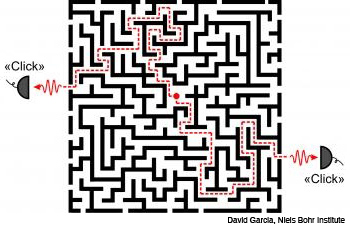
Particles threading a maze provide a metaphor for the way that photons travel through the medium by random scattering.
The wave nature of light is important for understanding how photons emitted in a complex disordered structure can mutually coordinate their paths. David Garcia and others at the Niels Bohr Institute at the University of Copenhagen (Denmark) recently showed that photons emitted by a quantum dot, embedded in a disordered photonic crystal (Phys. Rev. Lett. 109, 253902).
The emitters probe in situ the microscopic details of the medium, and imprint such near-field properties onto the far-field correlations. Thus, although light scattering is a random process, different paths can be correlated encoding information about the medium.
Particles threading a maze provide a metaphor for the way that photons, emitted from a light source in the center of a complex medium, travel through the medium by random scattering. The photons take different paths but are interdependent in the sense that that the chance of observing a photon at one outlet is increased if a photon is observed at the other outlet.
Garcia explains, “The photons are scattered in all directions … But photons are not just light particles, they are also waves, and waves interact with each other. This creates a link between the photons and we can now demonstrate in our experiments that the photons’ path through the material is not independent from the other photons.”
The method might someday measure the spatial properties of complex disordered materials like biological tissue.
